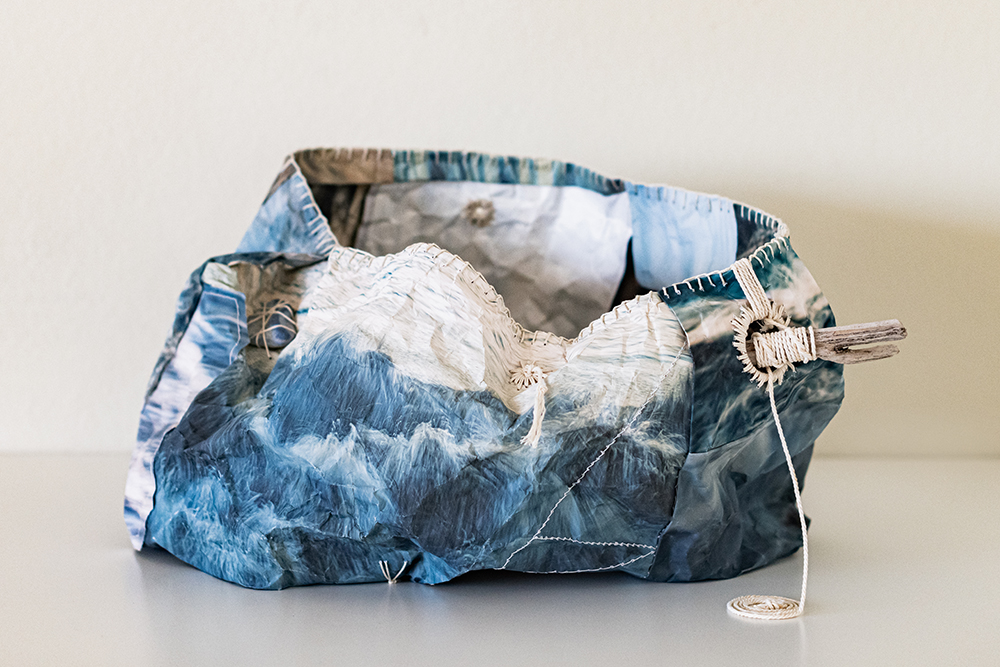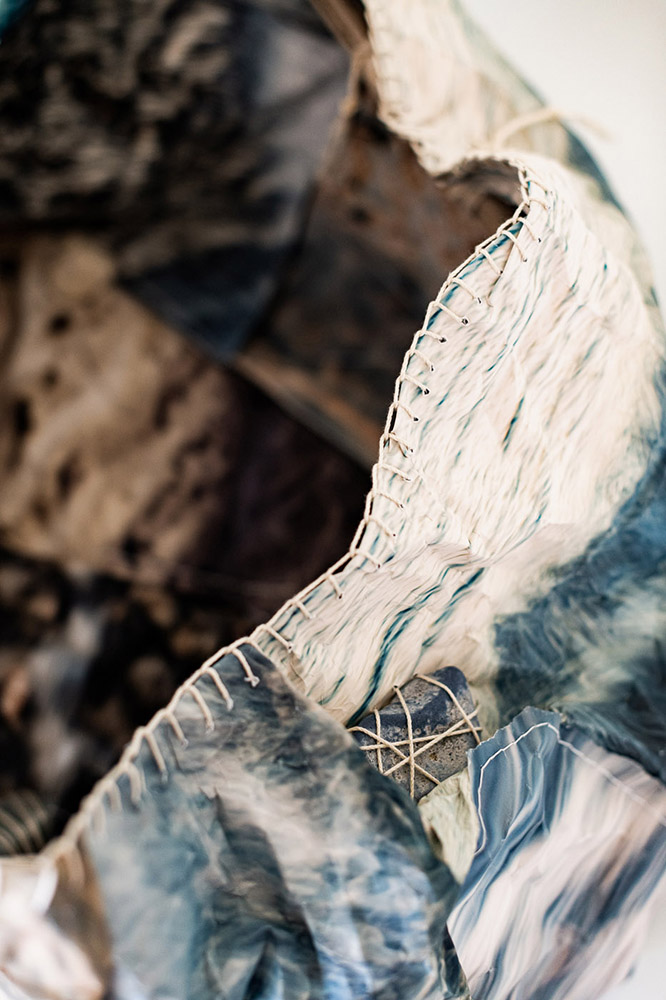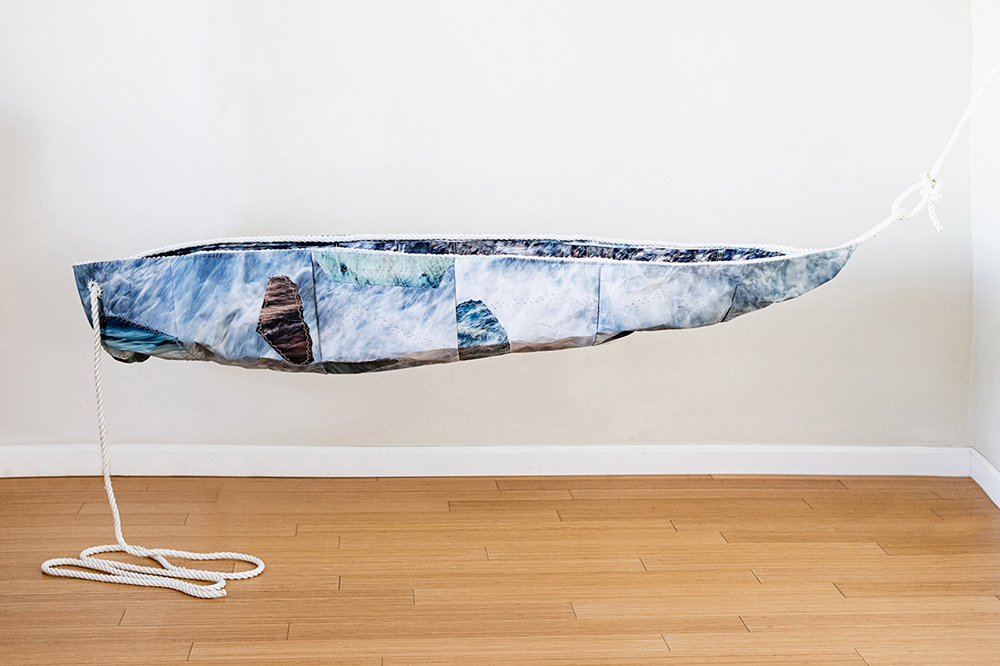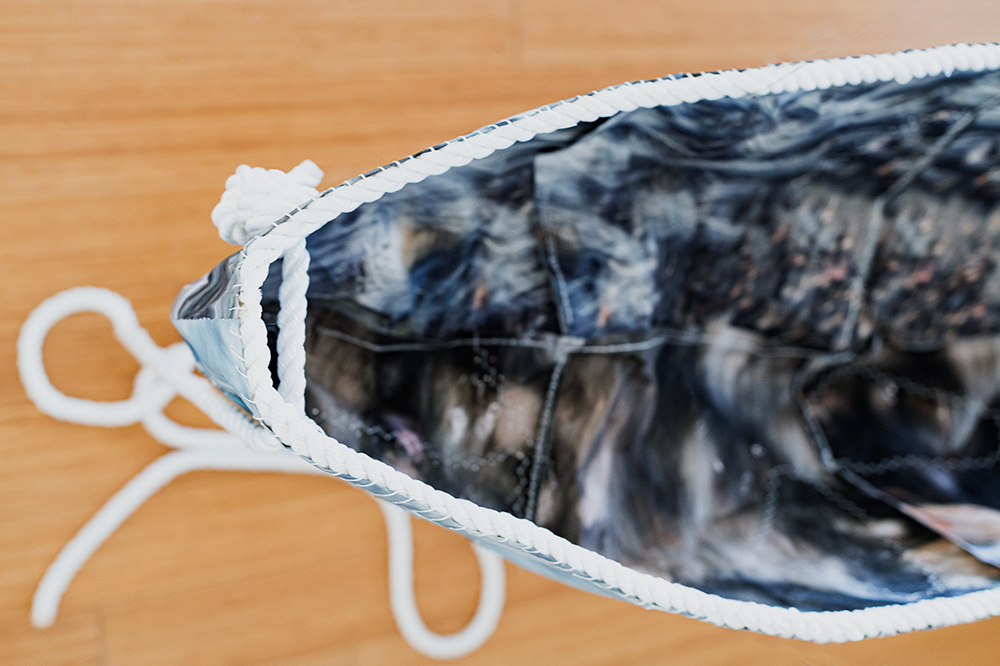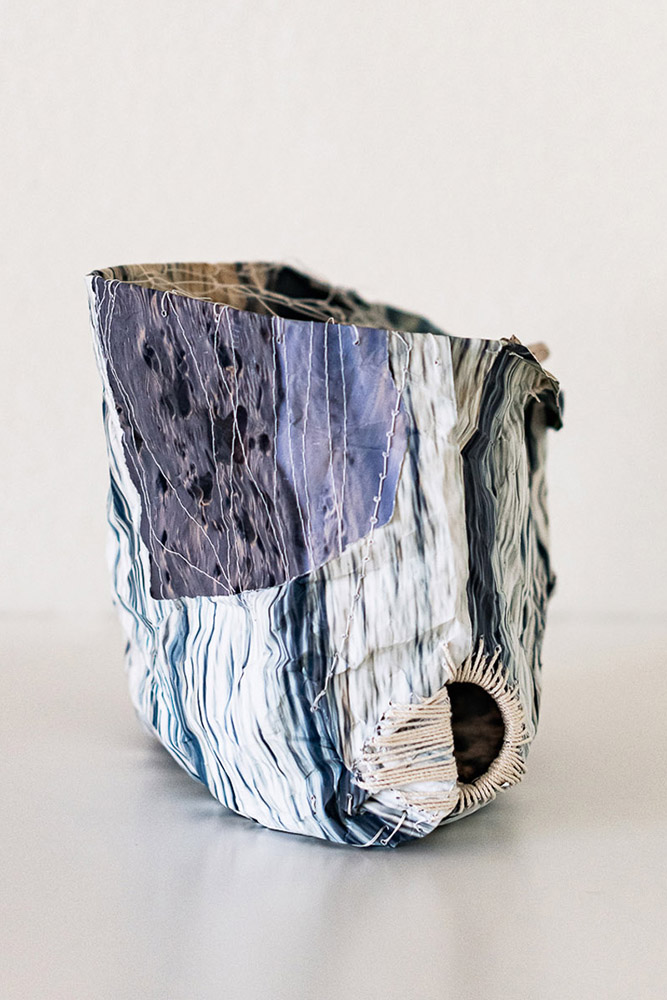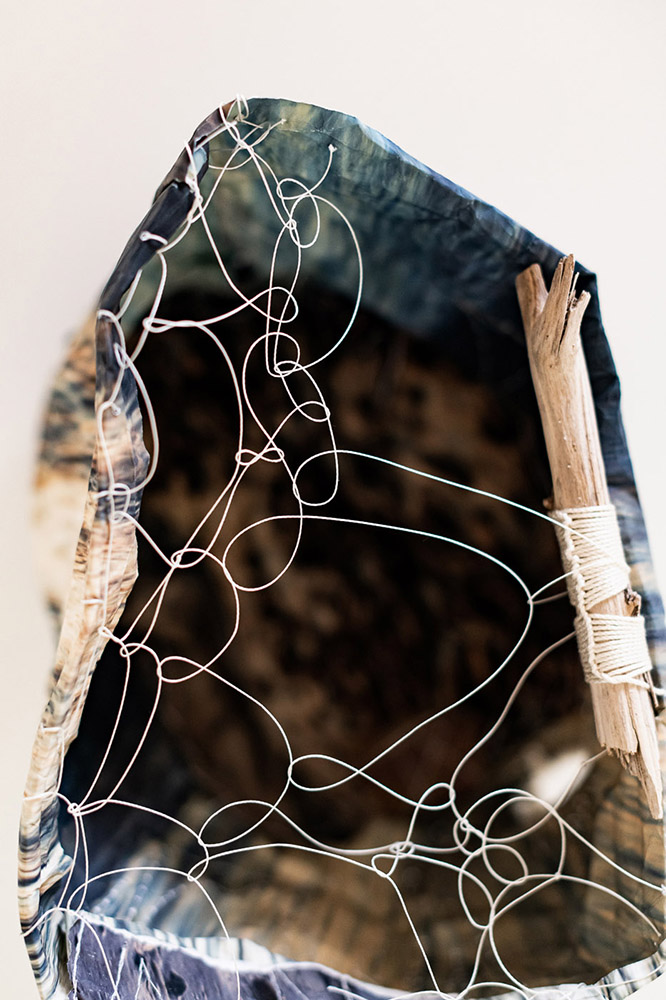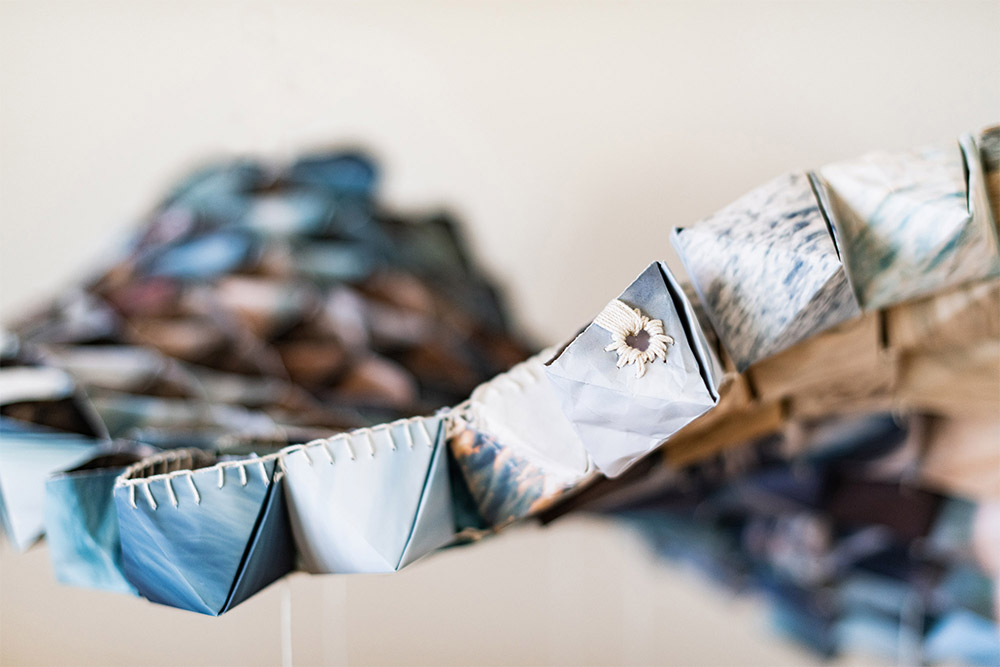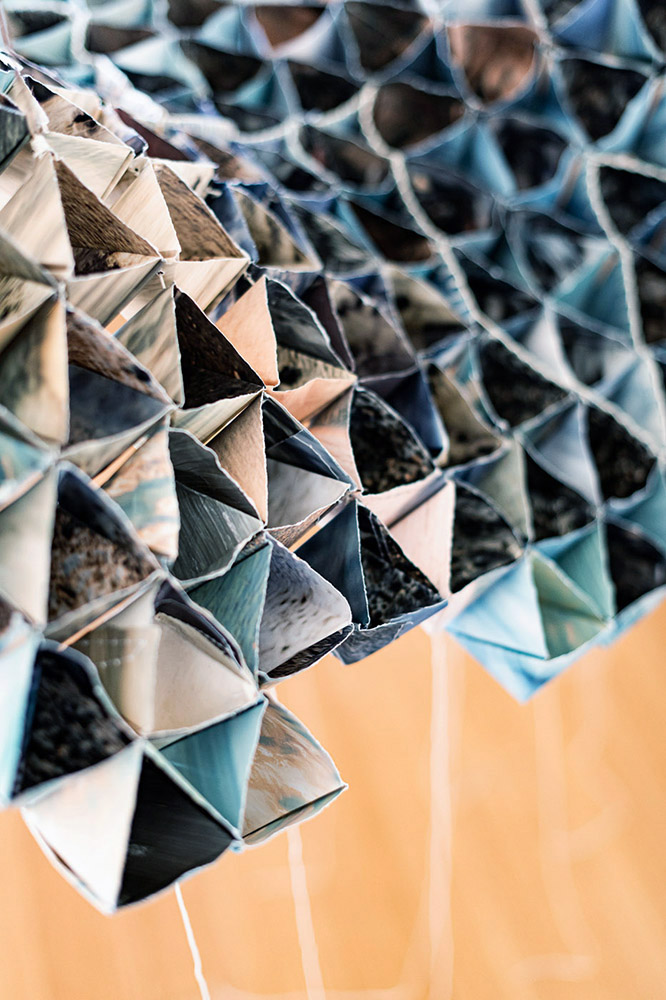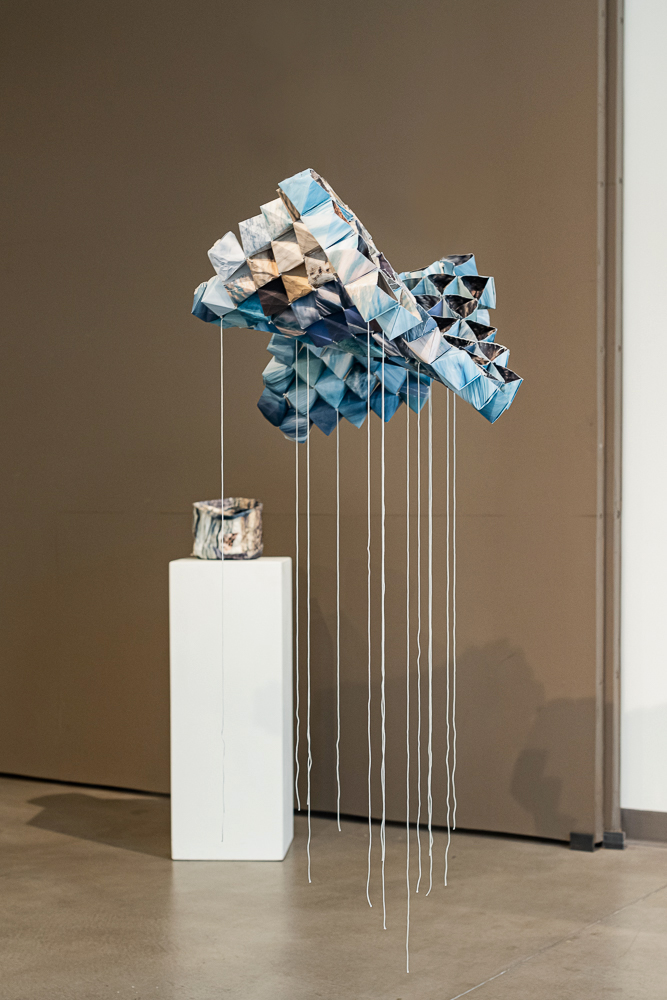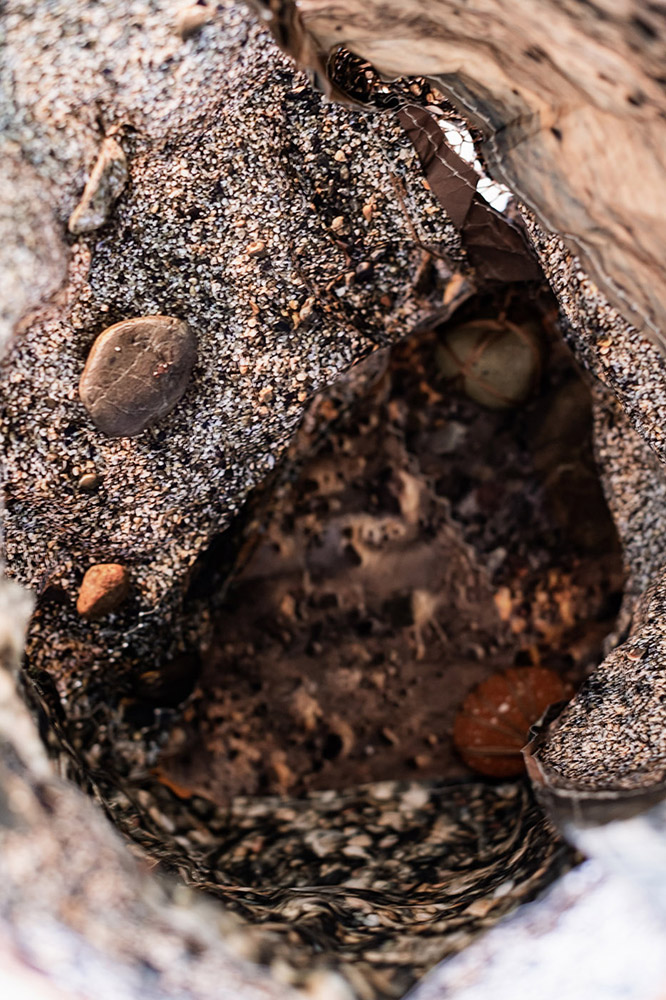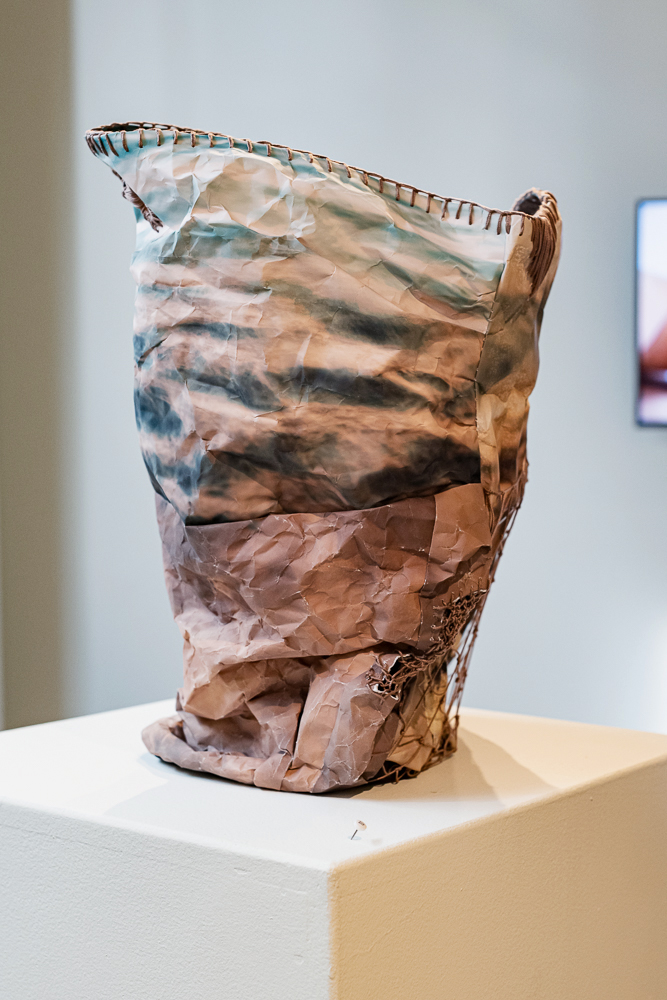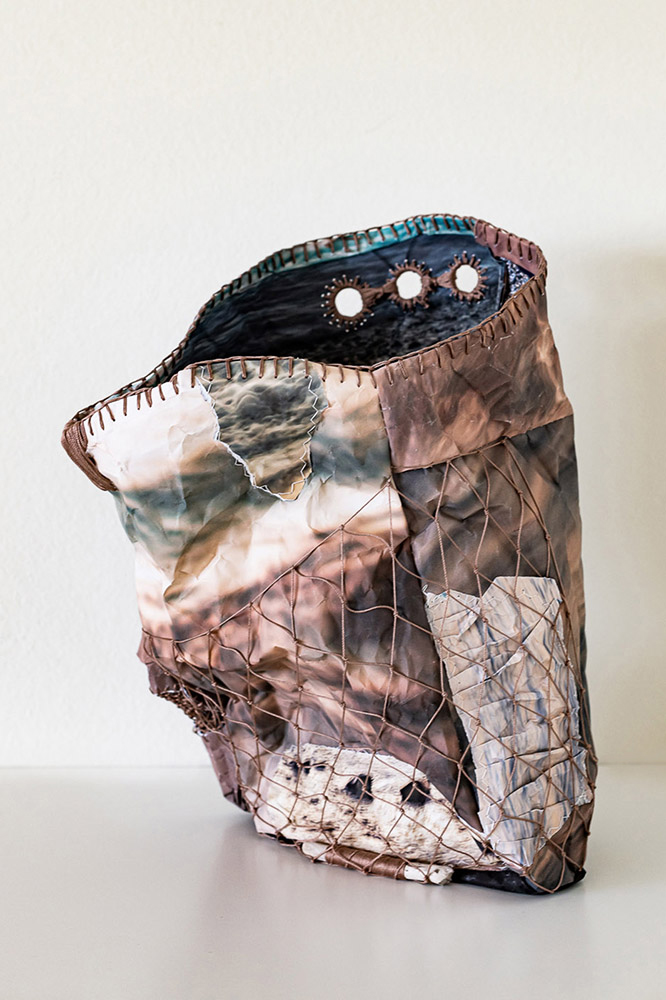Photography + Form Week: Kristianne Riddle
Photography is my first love, but at times I feel that it falls flat for me (how ironic) and I seek out other ways that may tell the story more effectively. While researching for my own photo based projects, I often come across the work of others who push the medium far into new corners through the use of textiles, thread and sculptural elements or any combination thereof. Due to the saturation of images, it seems that some artists have been less inclined to use photography as a language but rather as a form to recreate objects such as textiles, 3-dimensions or a combination of both. The artists featured this week are all inspired by imagery or choose to create sculptural elements with in their imagery to create a layered investigation of their worlds. – Maggie Meiners
Using the landscape and natural environment as her canvas, Kristianne Riddle creates beautiful 3-dimensional sculptures where both discord and grace coexist as seen in her project, Tension of Flow. During a transitional phase of her life, Kristianne felt compelled to resolve disenchantment around marriage, motherhood, and her career. While trying to settle into the opposing paths as a moored mother and wife, her lifelong dreams of living untethered adventures of peril and enterprise began to drift away. Using crumpled photographs, sewing, tearing, hitching and mending as techniques, her hands-on process allows her to express a new language without the constraints of precept.
Kristianne Riddle was born and raised in a small California beach town and grew up in a family of professional travel guides. After receiving her BFA in photography, she set off on her own adventures and honed her expedition skills in the mountains of California, Colorado, and Mexico while guiding for the Sierra Club and the Colorado Outward Bound School. Soon after she met her husband they set out on a life-changing adventure together sailing a 38′ sailboat 8,000 miles from San Diego, CA to French Polynesia and north to Hawaii over the course of a year.
Kristianne is a visual artist captivated by works on paper, installations, and book arts. Common themes are personal narrative and its intersection with environment and motherhood. She received a BFA in Photography from California State University at Long Beach. She taught photography at CSUF, has held photography workshops, and lectured at CSULB. Her work was a Critical Mass finalist and has received recognition from Luerzer’s Archive, and Communication Arts Magazine.
When she’s not in her studio or creating on location, she is exploring the California coast by sailboat with her husband and teenage son and daughter. Kristianne and her family are currently refitting a 46’ Kelly Peterson offshore sailboat to sail to the Sea of Cortez and beyond.
Finding balance between her thirst for adventure, freedom, and spontaneity while settling down with a routine to raise a family has heavily influenced her work. She is nestled into her hometown, for now, to be near family.
The Tension of Flow
The Tension of Flow holds a place where both discord and grace coexist. After many years of confusion and turmoil, I felt compelled to resolve disenchantment around marriage, motherhood, and career. While trying to settle into the opposing paths as a moored mother and wife, my lifelong dreams of living untethered adventures of peril and enterprise began to drift away.
In the pursuit of bringing disparate parts of myself together and honoring the tension of my dilemma, I began to spend my time folding, crumpling, tearing, sewing, and forming photographic prints of the ocean crashing on a rocky shore.
I use lashing, hitching, and mending techniques from my sailing and mountaineering background to fashion the photographs, thread, and rope into symbolic forms and vessels.
The hands-on process allows me to express a new language without the constraints of precept. The finished pieces honor the tension of opposites that I have learned to reconcile during this tumultuous chapter of my life.
Tell us about the landscape of your childhood and how you came to be an artist.
I grew up in a small beach town in Southern California. My family owned a travel agency that my grandparents started in the 1950s after leaving Nebraska. My grandfather was a self taught artist. He had an air brush studio in the back of the travel office. As a young girl I would spend hours with him helping place scrap metal weights on his airbrush stencils. He created elaborate window displays using airbrush art, sawzall cutouts, illustrated travel posters, and rotating light projections. I grew up surrounded by graphic design and photography of idealized locations around the world.
All my life I was told by my family that I was an artist. I always had projects going on-from making my own paper to sewing and making books or sculptures. I spent hours closed up inside the forward berth of our 27’ sailboat making things.
Even in college my parents encouraged me to work toward an art degree while all my peers were expected to go into business or engineering. In the fine art department at CSULB I discovered photography. At that time photography was just being recognized as an art form. Even in the college there was a controversy about it being in the fine art program versus the graphics program. Many people in the fine art community didn’t accept it and I loved that provocation. This is what ultimately drew me to photography. That and the fact that I could spend hours alone in a dark room making images for assignments.
I experimented with and created work in a variety of processes: from contact printing Polaroid instant slide film and high contrast litho film to platinum and Cibachrome printing. However, I found myself drawn to working in dimensional media that incorporated photographs. I created cyanotypes printed on coated linen which hung as panels on a wardrobe rack in the gallery. I incorporated glass, thread, and brass into my photographic work and was also an avid printmaker and book maker binding my photographic prints and transparencies into various forms using paper, metal, twine, and fabric. I did this until I graduated and needed to make a living. So now after years of putting this intuitive process aside to make commercially relevant art I was craving to get back to the hands-on dimensional process that was a huge part of how I started out intuitively communicating.
What was your first meaningful encounter with art?
My very first meaningful encounter with art was at the Newport Harbor Art Museum in 1988. I was in college and already studying art. The exhibition which included Bill Viola’s “Theater of Memory” struck a chord in me that I have never forgotten. Viola says of this work: “… another image in my mind was of this tree I saw while hiking in the Sierras. There was this fallen giant with the trunk on the ground and the roots up in the air. This image of roots is something one sees everywhere in nature, in the shape of a lightning bolt, in the way a river looks from the air. . . . All these things stewed in my head for a while. Then, I saw it in a flash, the lights on the tree, the lights flickering.” I love how he incorporates image technology into his installations to create deep, thought provoking commentary on birth, death, and consciousness.
How does photography influence/inform this body of work and visa versa?
My photography has been slowly inching toward a sense of restless turbulence in response to breaking free of control and perfectionism. After I graduated BFA, I went into commercial photography to pay the bills. This world requires control and precision. So to help find my way out of these confines, I started creating images in the ocean. This allowed me to express a new visual language for flow, ebullience, and animation in my advertising work. This photographic style then began to expand in new ways in my personal work.
At the same time, I had been longing to express my struggle with finding flow in other areas of my life-especially those influenced by relationships. This had been stirring for a couple of years before the pandemic started so by the time I was in lockdown I had heaps of field notes to use for The Tension of Flow both in words and pictures. I began intuitively making photographs of the ocean and the rocks at the water’s edge as I took long walks on our empty beaches to express what I had been needing in my life. But the photographs felt shallow for what else I was wanting to say. They were accurately expressive but I was longing to manifest something deeper and more expansive.
During the years I started The Tension of Flow I had already created structural forms out of my photographic prints: ornaments, vases, bowls, boxes. They were merely things I made for my family, friends, and clients. But I didn’t know what to do with them in my art practice. I knew that I wanted to make a series of vessels. Then one day I was sewing a 45×60 foot sail from my sailboat. I was getting really into the process of sewing using my sailmaker’s sewing machine. I had to use my whole body to push the sail through the machine and it was very physical. It was what I had been craving. I was entranced. It was then that I recognized I needed to combine my two worlds somehow-sailing and photography. I began to sew my photographic prints into vessel shapes.
Now that I have created these photographic sculptures I can’t imagine I will ever go back to straight photography. This is my language. The process of sewing, mending, shaping, and handling a dimensional object feels so authentic. This process now informs how I make my photographs. I see things differently. My process has come full circle to being engaged and physically immersed in my environment whether I’m photographing or making sculptural pieces.
How does photography integrate into your current medium? Or if you are still using photography how does it relate to the other materials that you are using?
Photography is usually printed on paper and my absolute favorite medium to work with is paper so the marriage is elemental. I found a fabulous paper that is printable on both sides which was incredibly important to this work. I really wanted the duality of my life to be expressed in that way. I often create diptychs in my work but this is a very unique way of creating a diptych which I relish. The paper has an incredible feel to it and it’s very durable. It feels like a fine fabric and it holds up well with the sewing and crumpling I do to turn it inside out.
This new manifestation is so exciting to me because I still get to use my photography to express my ideas but now I am creating something entirely new and structural that also circles back to aspects of my art that I had previously abandoned. Other materials like thread, brass rings, and driftwood, meld into the paper forms without overwhelming them and suddenly my work is alive and breathing. They are a form without function.
What process is used in deciding what materials to use when it comes to taking it from straight photographs to something of another dimension?
I decided on the materials for this particular series because I was recently working with them and had become very familiar with them. Since these pieces are designed as vessels I wanted to use traditional materials found on sailboats. Rope, twine, cordage, and thread are all a part of my sailing life. I use these materials to make sails, handles, knots, ties, and embellishments on my sailboat.
After sewing or folding the photographs together I treat them like sail cloth or canvas on a sailboat. I use sailmaker’s thread and twine to enhance the edges and repair tears made while shaping the vessels. The bolt rope is applied as it would be on a sail: to reinforce the edges.
The brass rings are sewn on as cringles which are traditional enhancements to a sail so it can accept attachments such as line. I thought that this was fitting for my project because the concept is how I’m experiencing the tension of flow as a wife and mother who needs to “accept attachments” while still being able to maintain my sense of self. I can’t imagine how I would express that in a straight photograph any better without being too on the nose for my taste.
The paper, thread, rocks, and wood are part of a natural family of materials that are also ecological. When you live on the water you think about the environment every moment. I use brass rings that are an alloy of copper and zinc which are two important elements used on boats to prevent oxidation and corrosion by salt-water and salt-laden atmospheres. These endemic accents are important to my work because I like to work with treatments that are understated, figurative, and curious.
What were you reading, watching, or listening to while making this work? If you don’t remember, can you tell us what pieces of literature, art, or film may have helped direct this work?
I had been doing a lot of reading about vulnerability and parenting an Asperger’s child while starting to concept The Tension of Flow. Rising Strong: How the Ability to Reset Transforms the Way We Live, Love, Parent, and Lead by Brene Brown had ideas that resonated with me while I was trying to express the tension of paradox in my life. I was reading The Alchemist by Paulo Coelho and Diary of a Sea Captain’s Wife by Margaret Holden Eaton as well. I often read sailing and adventure stories that help free me from domesticity and this is why this project had to manifest. It had been stirring in my mind for several years and I couldn’t move past it to other projects until it found its voice.
A common theme in my work and my thoughts is how to live with both what I don’t want in my life and what I do want in my life. There is an innate paradox to life that most people don’t recognize or want to acknowledge. The Tension of Flow has helped me figure out that life is bittersweet and we must learn to accept the sadness while also accepting the joy. Sometimes the way to your dreams is a path with a lot of twists and turns and once we accept that and go with the flow, we can bring about so much more in our lives.
What are you working on currently and does it relate to photography? If so, how?
Photography is my primary instrument of connection. Everything I do relates to my interaction with photography in some way. I will always use it to communicate personal ideas about life and the way I see it. I continually have a multitude of concepts brewing. Ideas around my personal story and its intersection with climate and women’s issues are the most immediate themes that bubble up for me.
Currently I am researching and writing about the Intertropical Convergence Zone. I passed through it twice in the year 2000 in the middle of the Pacific Ocean. It was the most bizarre place I have ever been. It felt as if I passed through a portal to another world (thresholds are a common theme in my work) and I wrote about it and drew pictures of the experience. I also took photographs and collected water while I sailed through. I have always been fascinated by weather and my consciousness of it is a huge part of my diurnal schedule just like eating and breathing. So I know my project will incorporate photographs and water I captured in the ITCZ and will address the confluence of environment and hindsight but I haven’t quite figured out how the works will manifest. I just need to start playing more with the materials and let them guide me.
In the meantime, I am still expanding The Tension of Flow. Each type of form I have created can spin off into a derivative motif. The vase shapes represent me individually in the flow, the larger boat shape is symbolic of me in the family trying to find flow, and the waveform is an expression of me in my community finding flow in the tension there.
Maggie Meiners (b.1972, Chicago) Maggie Meiners is an interdisciplinary artist whose work revolves around self-critique. Heavily influenced by image culture and how it personally affects her, Meiners deftly deploys photography, stock imagery, film stills, cultural artifacts and magazines to tackle subjects such as identity, gender, and social status. Using appropriation, assemblage, film making and installations, Meiners explores the psychological affects of popular imagery on her psyche.
Her interests lie in deconstructing the current cultural narrative as a way of empowerment and defining her personal identity. The internal conflicts that manifest from the constant barrage of the media as well as societal expectations (both self-imposed and external) within the current social construct are also represented in her work. Using these varied modes and mediums, Meiners’ work highlights feminism and contemporary notions of gender, domesticity, beauty, consumption, and body image. Humor and subversive messaging in Meiners’ work is relayed as an abundance of bright, often lurid colors and textures in jarring, frenetic, and imperfectly arranged pieces. Such arrangements evoke the essence of simultaneous desire and absurdity, a psychological manifestation of our culture of perfection and truth.
Maggie’s art has been widely exhibited and remains in the permanent collections of the Illinois Institute of Art, Wheaton College, Harrison Street Lofts, Fragomen, Del Rey, Bernsen & Loewy, LLP and numerous private collections. In addition, her work was on loan at the American Embassy in Uruguay from 2016-2019. Maggie had her first solo exhibition in 2005 at The Union League Club of Chicago– one of the most esteemed private collectors of art in the country and is represented by the Anne Loucks Gallery in Glencoe IL.
Follow Meiners on Instagram: @MaggieMeinersProjects
Posts on Lenscratch may not be reproduced without the permission of the Lenscratch staff and the photographer.
Recommended
-
Tara Sellios: Ask Now the BeastsApril 6th, 2024
-
ALEXIS MARTINO: The Collapsing Panorama April 4th, 2024
-
Emilio Rojas: On Gloria Anzaldúa’s Borderlands: The New MestizaMarch 30th, 2024
-
Artists of Türkiye: Eren SulamaciMarch 27th, 2024
-
Love and Loss in the Cosmos: Valeria Sestua In Conversation with Vicente IsaíasMarch 19th, 2024

